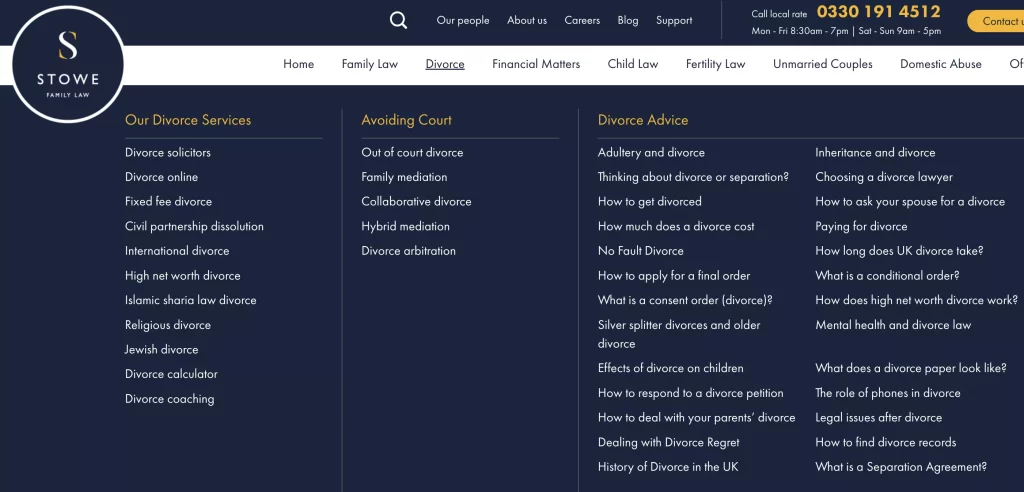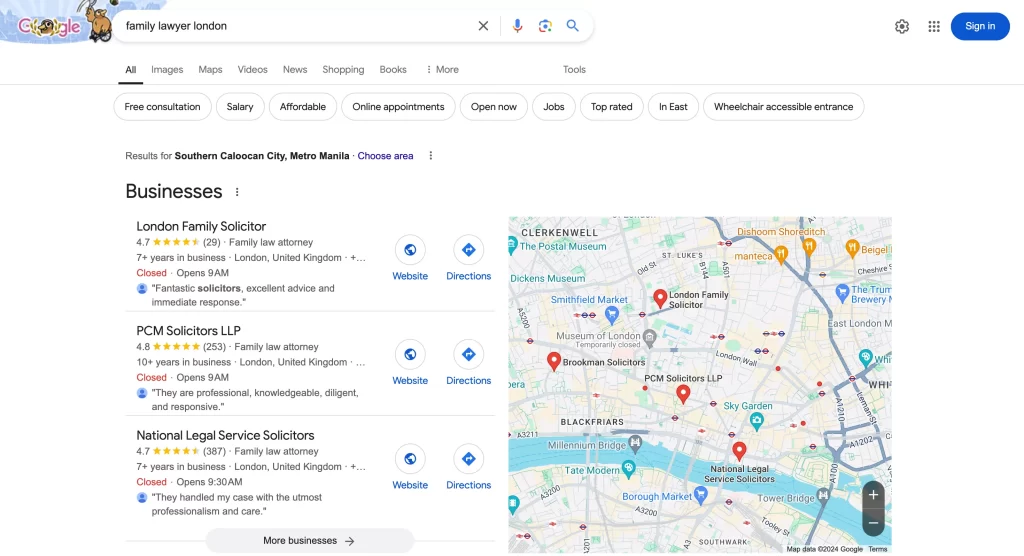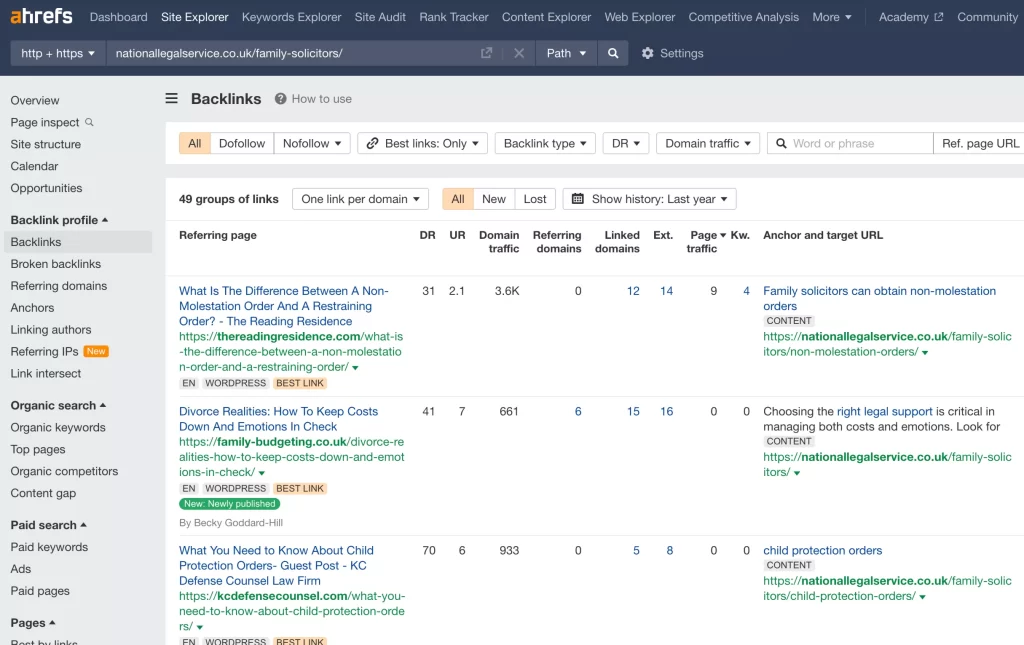In the competitive legal landscape, particularly in family law, getting online visibility is everything. With potential clients turning to Google to find legal services to serve their needs, having a lawyer website that dominates Google’s search engine results pages (SERPs) ensures you’re adding a mix to your marketing strategy.
Working with law firms, I’ve noticed that, more often than not, a typical legal website is just a repository of landing pages that aren’t fully optimized for search, leaving clients with few opportunities to find their legal services.
In this quick guide, we’ll look at the fundamentals of SEO for family law to attract more clients.
1. Structure Menu Items Based on Hierarchy
One way to improve user experience and your site’s ability to rank for search is to structure your menu items in a clear, hierarchical manner. This involves arranging the main categories and subcategories in a precise, logical sequence.

A well-structured menu helps users navigate the website more intuitively and ensures important pages are discovered and indexed correctly. This can improve overall site coverage and rankings for your key pages.
For instance, a parent category labeled “Services” might have categories like “Divorce and Separation”, “Child Custody and Support”, and “Mediation Services”, with more specific landing pages.
Here’s how it looks like in order, for example:
Services
- Divorce and Separation
- Child Custody and Support
- Property Division
- Spousal Support
- Child Custody and Support
- Custody Agreements
- Visitation Rights
- Child Support Modifications
- Mediation Services
- Divorce Mediation
- Family Dispute Mediation
- Child Custody Mediation
- Prenuptial and Postnuptial Agreements
- Adoption Services
- Domestic Violence
- Restraining Orders
- Emergency Protective Orders
2. Rank For Local Organic Listings and Google Map Packs
Local SEO is a critical component for family law firms, as a typical scenario for most clients seeking lawyers near their homes.
Having your legal website at the top of local organic listings and Google Maps packs helps drive new inquiries for your law firm.

Here are a few action items to optimize your family law site for local search:
- Claim and optimize your Google My Business (GMB) profile.
- Ensure that the firm’s name, address, and phone number (known as NAP in local SEO) are accurate and consistent on your site and other off-page sites, such as citations and local directories.
- Incorporate location-specific keywords in your site’s content, such as “family lawyer in London” or divorce attorney in Brighton”.
- Produce helpful content that resonates well with the local community. Topics may include local laws affecting family matters and comprehensive guides on navigating divorce in your city or region.
- Be listed in citations and legal directories. Your firm should be listed in reputable legal platforms like The Law Society’s Solicitor Directory and The Legal 500.
- Ask for reviews from clients. Reviews can help improve your GMB’s rankings for Google Map Packs.
3. Distribute External Content Assets
Contributing content assets to other relevant publications and blogs (guest posts) can help improve your site’s EEAT (Experience, Expertise, Authoritativeness, and Trustworthiness), as these qualities are showcased in the content’s caliber.
Through expertly crafted content pieces, you can demonstrate expertise and experience signals that won’t just attract referral traffic and direct visits but potentially assist conversions on backlinks from publications you’re contributing to.
One good example is this law firm in London that distributes content across relevant verticals, i.e., parenting, mommy, and family blogs. All of these have audiences where they can acquire potential clients.

Here’s my list of recommended topics where you can generate even more specific guest blogging ideas:
- Co-Parenting Strategies – Tips and advice on effective co-parenting after divorce, including communication strategies and conflict resolution. (parenting)
- Child Custody and Visitation Rights – legal aspects of child custody, visitation rights, and how to navigate the court system. (parenting)
- Divorce and Family Dynamics – the impact of divorce on family dynamics and how to maintain a healthy environment for children. (parenting and family)
- Financial Planning for Divorced Parents – how to manage finances post-divorce, including child support, alimony, and budgeting tips. (finance and family)
- Legal Rights of Parents: Information on the legal rights of parents in various situations, such as custody disputes, relocation, and schooling decisions. (parenting)
- Domestic Violence Awareness and Resources: Articles focused on recognizing, addressing, and escaping domestic violence, along with legal resources available for victims. (family)
- Prenuptial and Postnuptial Agreements: Educating readers on the importance of these agreements and how they can protect both parties in a marriage. (wedding, family)
- Adoption Process and Legal Considerations – legal process of adoption, including the rights of biological and adoptive parents. (family)
- Mediation vs. Litigation in Family Disputes: The benefits of mediation over litigation in resolving family disputes, including cost, time, and emotional impact. (family)
- Supporting Children Through Divorce: Psychological and legal support for helping children cope with the changes that come with divorce. (family)
- Estate Planning for Families: How to protect your family’s future through proper estate planning, including wills, trusts, and guardianship considerations. (real estate, family)
- Parental Rights in Same-Sex Marriages: Legal considerations and challenges. Unique to same-sex couples in matters of adoption, custody, and parental rights. (family, parenting, wedding)
The key to producing any of the mentioned topics is to align it with your contributor’s expertise and experience, as both these attributes will directly impact the quality of the content.
4. Ask For Links From Clients or Networks’ Sites
The legal industry heavily relies on networks to acquire clients. While this could directly affect how the law firm grows as a business, this network, in the form of clients and friends, is also a good source for link building.
You can ask for links from clients or people you’ve known who have their own websites. It may not be as relevant as it is. Still, from the local level, if the website happens to be hosted within a geographic area, it will have a solid value to your law firm, as local backlinks tend to bring more link equity as opposed to getting national links as its counterpart.
The Author
Venchito Tampon
Venchito Tampon is a Filipino Motivational Speaker, Corporate Trainer, and a Leadership Speaker in the Philippines. He is the CEO and Co-Founder of SharpRocket, a link building agency. With a decade of experience, Venchito has a proven track record of leading hundreds of successful SEO (link builidng) campaigns across competitive industries like finance, B2B, legal, and SaaS. His expert advice as a link building expert has been featured in renowned publications such as Semrush, Ahrefs, Huffington Post and Forbes. He is also an international SEO spoken and has delivered talks in SEO Zraz, Asia Pacific Affiliate Summit in Singapore, and Search Marketing Summit in Sydney, Australia. Check out his other businesses, Hills & Valleys Cafe, Blend N Sips and Saas Pursuit.
How our LINK BUILDING AGENCY in UK builds 250 links/mo consistently using Predictable Link Building Methodology™…
- Using a SIMPLE and PROVEN system
- Using a SCALABLE strategy
- No private blog networks
- No creepy outreach emails

